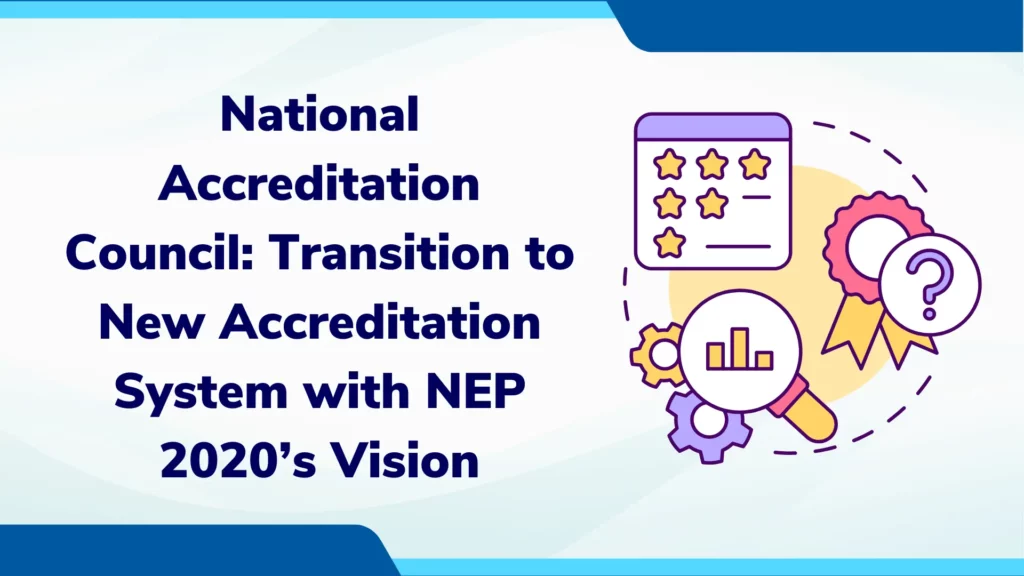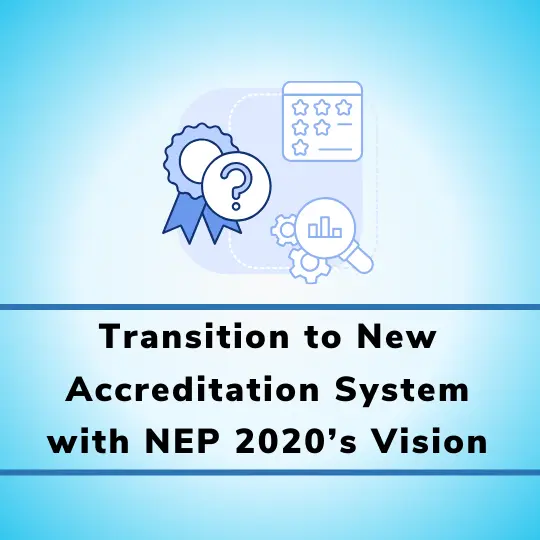
Article Contents
Introduction
What is currently shaking up the landscape of higher education in India? It’s the visionary National Education Policy (NEP) 2020! How is this policy bringing about change? By completely transforming various aspects of the system, like regulation, accreditation, funding, and academic standards!
So, what’s the big deal? It’s all about setting up the Higher Education Commission of India (HECI) and its four separate sections. And guess who’s playing a crucial role in this transformation? The National Accreditation Council (NAC)!
In India, multiple agencies, including the University Grants Commission (UGC), the National Assessment and Accreditation Council (NAAC), the National Board of Accreditation (NBA), and the All India Council of Technical Education (AICTE), have been responsible for approving, assessing, accrediting, and ranking higher education institutions (HEIs).
However, the National Education Policy 2020 (NEP 2020) recognizes the need for a revamped and unified system that places distinct bodies at the forefront. Isn’t that amazing? By transforming the way institutions are assessed and acknowledged!
This article focuses on the role of the National Accreditation Council (NAC) and the transition towards a new accreditation system in line with NEP 2020’s vision.
A Glimpse of Traditional Systems
The current systems in India for Approval, Accreditation, and Ranking of higher education institutes (HEIs) follow:
1. National Assessment and Accreditation Council (NAAC)
NAAC is a centre within the University Grants Commission (UGC). It’s responsible for evaluating and certifying Higher Education Institutions (HEIs) every five years. Their assessment looks at the whole institution to determine its quality and effectiveness.

2. National Board of Accreditation (NBA)
NBA is now an independent organization overseen by the Ministry of Education. It rates technical programs for either 3 or 6 years. Being part of the Washington Accord streamlines how engineering programs are accredited globally.
3. All India Council of Technical Education (AICTE)
AICTE supervises programs in technical education. It checks and approves courses in technical institutions each year, following processes laid out in the AICTE-Approval Process Handbook. Their online system keeps things efficient.
4. National Institutional Ranking Framework (NIRF)
NIRF started in 2015 and ranks institutions annually based on different factors. The ranking work is carried out by the NBA on behalf of NIRF. This helps students and parents make informed choices about where to study.
Over the course of six years, each of these organizations has gathered information from the participating Higher Education Institutions (HEIs). This information they collect might be identical or quite similar, as shown below:
Global Best Practices on Accreditation
The UGC’s Committee carefully studied and analyzed the best practices used by accreditation agencies in countries like the USA, Canada, Europe, Australia, and Japan. Based on this study, the committee made the following observations.
- In many countries, accreditation is not just for giving degrees, but also for becoming a professional engineer.
- The results are usually clear-cut i.e. They are either accepted or different degrees of not accepted. Sometimes, a request for accreditation can be denied outright, or a university might get more time to meet the requirements.
- They measure how well students are learning by looking at their test papers, question difficulty, and grades. They also conduct student interviews and are used in the assessment to understand learning levels.
- Accreditation agencies form out how satisfied students and faculty are through surveys. To ensure honesty, they often conduct interviews anonymously, without the university interfering.
- The forms used are short and simple.
- All important documents, like facility details, faculty information, student numbers, courses, teaching plans, lectures, and assignments, are available to the public. They are very strict about following the rules and taking strong action if institutes do not fulfil them.
- It is common to show what students are supposed to learn to the public. This helps everyone check and understand.
- The cost is higher in those countries compared to India for accreditation, but they have strong, scientific mentoring through every step of the accreditation process: before, during, and after.
The Vision of NAC
The NEP 2020 plans to change how Higher Education is regulated. It wants to create separate, strong groups for regulating, accrediting, funding, and setting academic standards. These groups will work together under a bigger institution called the Higher Education Commission of India (HECI).
One part of HECI is the National Accreditation Council (NAC), which will be like a top accrediting body known as a ‘meta-accrediting body’. NAC will watch over other accrediting groups to make sure they’re doing things right.
| Current Accreditation System | NEP 2020 Vision for Accreditation |
| Accreditation is based on scores and grades. | Binary accreditation: accredited or not accredited. |
| Institutions disclose data through a portal. | Institutions share information publicly for transparency. |
| Evaluation by peer teams approved by authorities. | Accredited institutions conduct evaluations. |
| Uniform approach for all institutions. | A tailored approach based on university type. |
| Assessment of inputs, processes, and limited outcomes. | Evaluation emphasizes outcomes and performance. |
| General policy benefits encourage participation. | Empirical policy benefits introduced for active motivation. |
On March 22, 2023, an important brainstorming session took place. Officials from the Ministry of Education, UGC, and AICTE were part of this session. They discussed and made a decision. They decided to get ready to switch to the new system by December 31, 2023, with a strong focus, just like a mission.
NEP 2020 Guideline on Accreditation
In the future, an institution’s approval will typically depend on basic standards, openly sharing information, proper management, and the results they achieve. This process will be managed by a group of accrediting organizations that work separately and are watched over by NAC. NAC will choose a suitable number of institutions to become official accreditors.
In the near future, a strong system of different levels of approval will be developed. This system will define specific steps that all Higher Education Institutions (HEIs) should take to reach a certain level of quality, self-governance, and autonomy.
Therefore, all Higher Education Institutions (HEIs) will try hard to achieve the highest accreditation level in the next 15 years. This will be done by following their Institutional Development Plans (IDPs). This way, HEIs will in time work towards becoming self-managed institutions or groups that can grant degrees.
In the long run, accreditation will become a binary process, as per the extant global practice.
-By Ministry Of Education, India.
The NEP 2020 talks about how all the different parts of the Higher Education Council of India (HECI), like the National Higher Education Resource Center (NHERC), NAC, Higher Education Grants Council (HEGC), and General Education Council (GEC), will operate.
The usage of technology will be a lot to make things clear and open to the public. The goal is to work in a way that is fair and open, using technology to make everything efficient and easy to understand. The main idea is to have a transparent system that uses technology to make things simple and open, without needing direct contact.
Conclusion
In conclusion, the National Education Policy 2020 (NEP 2020) is reshaping India’s higher education landscape with a visionary approach. The pivotal role played by the National Accreditation Council (NAC) in this transformation is noteworthy. By streamlining accreditation processes and embracing global best practices, NAC aims to ensure quality and transparency in evaluating Higher Education Institutions (HEIs).
Under NEP 2020’s guidance, NAC is transitioning towards a more focused and efficient accreditation system. This new approach emphasizes binary accreditation—either accredited or not—while encouraging institutions to publicly share comprehensive information. The shift towards outcome-based evaluation and tailored assessments according to university types underscores the commitment to improving performance and quality.
Technology will serve as a crucial enabler, making the accreditation process transparent, efficient, and easily accessible to the public. The broader framework of the Higher Education Commission of India (HECI) will incorporate various bodies, including NAC, operating with fairness, openness, and simplicity through technology-enabled approaches. In summary, the National Accreditation Council’s alignment with NEP 2020 is driving a clear, open, and globally competitive higher education landscape in India.


